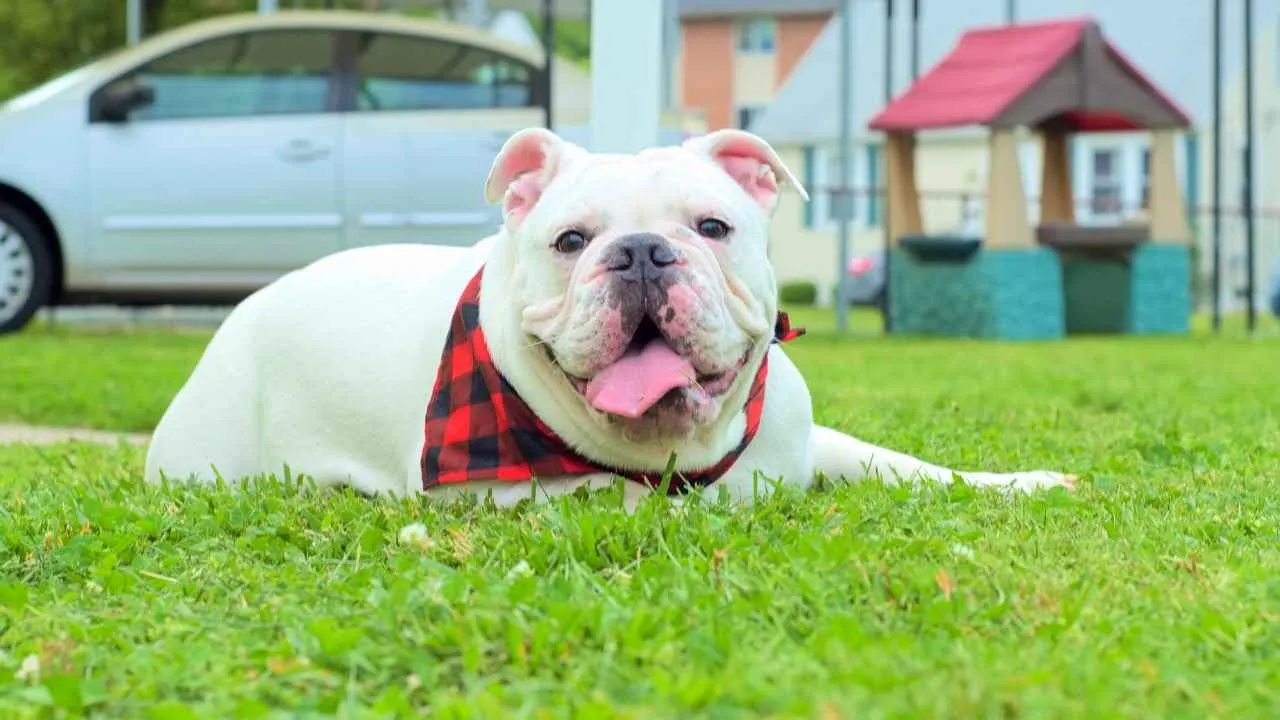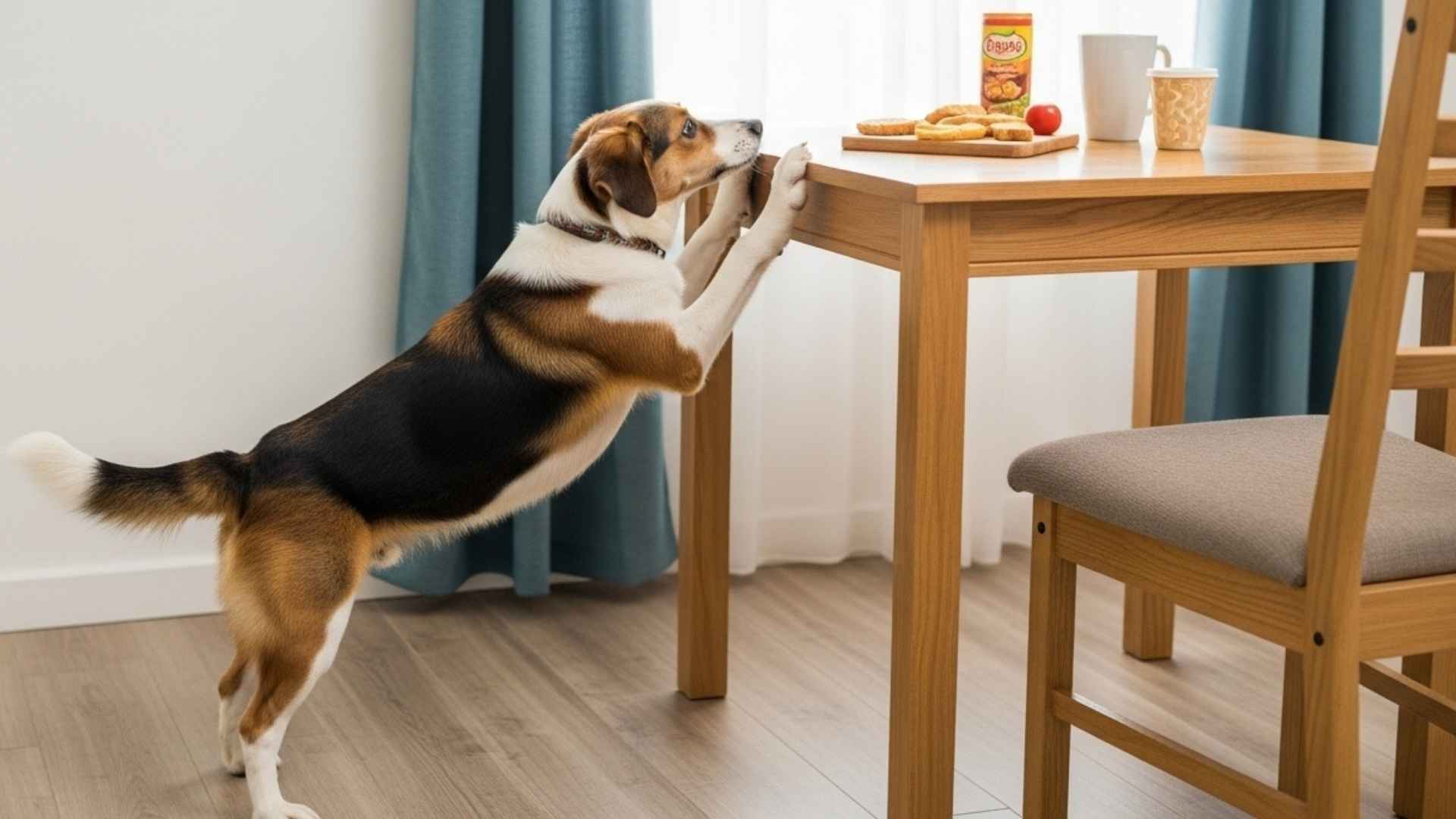Have you ever walked into your kitchen and thought, Why is that chair not where I left it? Then you spot your dog, sitting by the table, eyes wide, tail wagging, acting like nothing happened. It’s in that moment you realize—your pup just tried to outsmart you for a snack.
Some dog breeds don’t just love food—they live for it. They’ll push furniture, scoot crates, and shift toys to reach that one bite of human food left on the table. For these food-driven pups, the smell of a forgotten treat on the floor is enough to spark a mission.
Most dogs wait patiently by their food bowl, tails thumping with excitement at mealtime. But the snack strategists? They’re different. They treat your house like an obstacle course, using their body language and brains to climb, sneak, and grab. Working dogs, scent hounds, and clever couch surfers—these pups were bred to hunt or solve problems, and now they’re using those instincts on your dinner.
Dog owners know the signs—a nudged chair, a crate oddly placed near the kitchen, a toy shoved under the table. These little movements mean big plans.
Let’s take a look at the dog breeds that don’t just beg. They plot, they push, and they play the long game to get what they want—because when it comes to treats, no food bowl is ever quite enough.
Dog Breeds That Push Furniture to Reach Snacks
1. Labrador Retriever

As per AKC, the sweet-faced, lovable Labrador Retriever is one of America’s most popular dog breeds, year after year. Moreover, they are snack-chasing professionals. Dog owners often walk into the room to find a crate pushed, a chair nudged, or a table mysteriously moved, all in the name of food. Even after finishing a full food bowl, these pups act like they’ve been starving for days.
What makes Labs different from most dogs is a mutation in the POMC gene, which messes with their appetite control. They don’t feel full the way other dogs do. That’s why they’ll watch your every move during meals, following your body language like detectives waiting for a dropped crumb of human food.
Their behavior isn’t just cute, it’s deeply rooted. This breed turns every room in the house into a snack zone, pushing furniture, sniffing under tables, and climbing onto anything for a taste.
With proper training, feeding routines, and mental stimulation like puzzle toys, dog owners can help these lovable snack-seekers stay healthy and happy.
2. Dachshund

Dachshunds may be a small dog breed, but their food obsession is big. Dog owners often find these pups hovering under the table, scouting the kitchen floor, or even trying to push their crate closer to the pantry. If food is in reach, this clever breed is already plotting.
Originally bred to hunt, Dachshunds have a strong prey drive that easily transfers to treats. Their behavior around food is persistent—long stares, begging, and sneaky snacking when no one’s watching. Many will sit patiently, waiting for the perfect chance to grab a bit of human food.
While most dogs enjoy a treat, Dachshunds take snack hunting to a new level. Their low build might not help them jump, but in a quiet house, they’ll work every angle.
Because of their small size and back issues, portion control and feeding routines are essential to keeping this curious, food-loving pup healthy and happy.
3. Pug

Pugs don’t just love food; they live for it. These tiny dog breeds will push crates, shuffle furniture, and hover near the table like it’s their job. Dog owners often joke that their Pug can hear a snack bag open from across the house.
Because of their flat faces and limited exercise needs, Pugs are more prone to weight gain than most dogs. But that doesn’t stop them from begging with big, pleading eyes or sneaking bites of human food the moment your back is turned. Their behavior often becomes routine if we’re not careful.
Pugs are quick learners, especially when snacks are involved. If rewarded at the table once, they’ll try again and again. That’s why managing meals, offering healthy treats, and using puzzle toys are essential.
These adorable pups may be small, but their snack-stealing determination is mighty—and they’re not afraid to push their way to get it.
4. Beagle

Beagles love food more than most dogs. Dog owners often catch them pushing a crate or moving furniture just to get closer to the table. If snacks fall on the floor, a Beagle will smell them first—even from another room in the house.
The floppy-eared Beagle is a popular family dog who can also excel in the hunting field. So, their strong nose helps them track anything, especially human food. Beagles will sniff the food bowl, the trash, or even under the couch. Their behavior may seem naughty, but it comes from instinct.
Beagles are one of the top dog breeds that push furniture to reach snacks. They’ll do anything to grab treats.
To help them stay healthy, dog owners should use puzzle toys, give proper meals, and add some training. With the right tools, these smart pups can enjoy treats without turning the whole house into a snack hunt.
5. Golden Retriever

As per PDSA, the Golden Retriever is a muscular, sturdy dog with a big love for food. They were originally bred as hunting and working dogs, but today, they’re also beloved family pets and service animals. That’s partly because food motivates them so well during training.
Dog owners know these pups will happily sit near the table, watching closely in case a bite of human food drops. They’ll even push chairs, move crates, or sneak into the next room for snacks. Their smart behavior makes them expert food hunters around the house.
While treats help with obedience, too many can lead to weight gain. Puzzle toys and healthy meals can keep them busy and satisfied. A Golden’s big heart is only matched by their endless appetite.
6. Pembroke Welsh Corgi

Corgis may be low to the ground, but their food drive is sky-high. These clever dogs will push crates or toys to climb toward the table, just to score snacks. Dog owners quickly learn that no meal is safe when a Corgi is in the room.
Originally bred as working dogs, Pembroke Welsh Corgis now apply that same focus to finding food. They’ll watch your every move in the house, hoping a bit of human food drops during meals. From the floor to the couch, they treat every space like a buffet.
Their stubborn behavior and adorable puppy eyes can make training tricky. But with puzzle toys, portioned feeding, and consistency, owners can manage their snack obsession and keep this playful pup healthy.
7. French Bulldog

French Bulldogs are masters of silent guilt trips. They don’t bark for snacks—they sit, sigh, and stare like you’ve broken their heart. These pups will push toys or crates just to peek at the table and catch a whiff of human food.
Dog owners know the look: wide eyes, quiet patience, and the body language of a dog that believes it deserves every treat in the house. Frenchies were bred as companion dogs, and they’ve learned how to work that role perfectly.
Their food drive is strong, but their stubborn behavior can make training tricky. Puzzle toys can help, along with portioned feeding and limited treats. Too many snacks, and your little pup might outgrow the crate.
With firm boundaries and a watchful eye at mealtimes, Frenchies can stay fit without taking over the table.
8. Basset Hound

Basset Hounds are slow movers, but when it comes to food, they spring into action. These pups have powerful noses and will push past crates or drag toys just to sniff out snacks left under the table. Dog owners often catch them scouting the house like little detectives, tracking crumbs or sniffing out the food bowl—even if it’s empty.
Basset behavior is deeply tied to their scent-driven hunting past. They act like mealtime never ends, often begging with soulful eyes and slouched body language that melts human hearts. But don’t be fooled—this pup will sneak snacks from another dog’s bowl if you’re not watching.
To keep your Basset healthy, limit treats, use puzzle toys, and feed meals in controlled portions. A trim Basset is a happy explorer.
9. Cocker Spaniel

Cocker Spaniels are polite snack hunters. While most dogs bark or beg loudly, these pups sit silently by your table, using body language and those soulful eyes to ask for treats. Dog owners often find it hard to resist, but giving in reinforces this behavior.
These dogs are food-driven and will push a chair or jump onto the couch if it brings them closer to snacks. They respond well to training, especially when treats or puzzle toys are involved.
But remember, feeding from the table or offering human food can quickly turn into bad habits. Stick to measured meals in their food bowl and only offer healthy dog food. A consistent routine helps control their weight and keeps your pup happy, active, and well-behaved.
10. English Bulldog

Bulldogs may be slow movers, but when there’s food on the floor or snacks left on the table, they move fast—and yes, some will even push furniture to reach it.
These stocky pups love their dog food, treats, and anything that smells remotely like human food. Most dog owners know that once a Bulldog sets their eyes on a snack, no crate, rule, or toy will distract them.
Bulldogs often stare down humans during meals, silently begging for one bite. Their behavior is food-driven, so training with treats works well, but don’t overdo it.
Bulldogs easily overeat, so stick to scheduled feeding and watch those food bowls. In a cozy house, a Bulldog is a loyal pup, especially if there’s food involved.
Conclusion
Living with dog breeds that push furniture to reach snacks can be a hilarious challenge for dog owners. These clever pups don’t just love food—they strategize for it, nudging chairs and shifting crates just to reach the table. But with puzzle toys, portioned meals in their food bowl, and firm feeding routines, you can redirect their snack-driven behavior into something healthier.
Most dogs will wait by their bowl, but these determined breeds treat every room in the house like a hunting ground. Limiting human food, avoiding table scraps, and providing structured training are essential. After all, a happy pup isn’t the one stealing snacks off the counter—it’s the one thriving with control, enrichment, and love.


